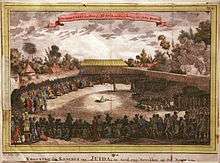Savi
For other uses, see Savi (disambiguation).

Crowning of the King of Whydah in Savi, April 1725, by Jacob van der Schley (1715-1779)
Savi (Also Xavier) was the capital of the Kingdom of Whydah prior to its capture by the forces of Dahomey in 1727.
An account of the city was given by Robert Norris in 1789
- "Sabee, at that period the metropolis of the kingdom, the residence of their monarch, and seat of their commerce, was about four miles in circumference. The houses, constructed with mud walls, were roofed with thatch. The factory houses of the European traders were spacious and airy, distributed into convenient apartments, and surrounded on the outside with a large gallery opening into balconies. The town swarmed with people, insomuch, that it was impossible to pass through the streets without great difficulty. Markets were held every day, at which were exposed to sale all sorts of merchandizes, European and African, besides abundance of provisions of every kind ... the plains embellished with an astonishing multitude of large and small villages, every one of which was enclosed with a low mud wall, and placed in full view of the surrounding district; all this assemblage united to form the most picturesque view imaginable, unobstructed either by mountain or hill."[1]
There were British East India Company, Dutch West India Company, French East India Company and a Portuguese trading compound in the city, adjacent to the Royal Palace.
Overall the city was very populous and filled with throngs of people.
References
- ↑ Monroe, Cameron. "Urbanism on West Africa's Slave Coast". American Scientist. Retrieved 24 September 2014.
- Norris, Robert (1789), Memoirs of the reign of Bossa Ahádee London: Printed for W. Lowndes.
- Ross, David. "Robert Norris, Agaja, and the Dahomean Conquest of Allada and Whydah" in History in Africa, 16 (1989), 311-324.
- Harms, Robert. The Diligent: A Journey through the Worlds of the Slave Trade. New York: Basic Books, 2002. p. 155-156.
Coordinates: 6°25′N 2°06′E / 6.417°N 2.100°E
This article is issued from Wikipedia - version of the 9/25/2014. The text is available under the Creative Commons Attribution/Share Alike but additional terms may apply for the media files.